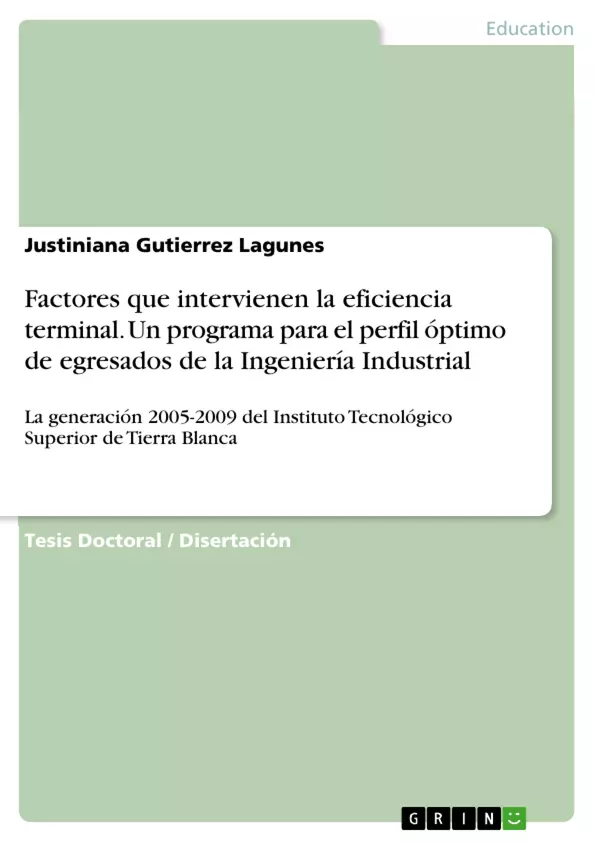Las situaciones vitales son ignoradas en la escuela y mientras los maestros explicamos un concepto, la estructura de significados de los alumnos se construye en otra dirección que puede ser contraria a lo que pretendemos. ¿Acaso lo advertimos? ¿Entendemos cómo se configura la condición humana en la vida escolar? Cuando advertimos el fracaso escolar ¿sólo se lo atribuimos al alumno? Finalmente es él quien queda excluido, ¿cuáles son las estrategias que desarrollamos para resolver nuestras situaciones vitales traducidas en problemas? ¿Qué hacemos realmente con nuestros problemas? ¿Le preocupa a las instituciones algo más que la eficiencia terminal?
Retomo el indicador de eficiencia terminal como un propósito prioritario en las instituciones y lo resignifico. Desde la perspectiva de la presente investigación, la eficiencia terminal es sólo un indicio para abordar la complejidad de un problema educativo. Generalmente, las instituciones consideran a la eficiencia terminal como un elemento enunciativo de los logros académicos o del fracaso escolar sin considerar el entramado que subyace. La eficiencia terminal desde este escenario representa una oportunidad para generar nuevas condiciones y entender quiénes somos, cómo estamos constituidos y cómo aprendemos, en el camino a la construcción de una escuela de la vida y de la comprensión humana (Morín 2002).
Inhaltsverzeichnis
- Kapitel I Marco Referencial: Instituto Tecnológico Superior de Tierra Blanca
- 1.1.1 Antecedentes
- 1.1.2 Filosofía
- 1.1.3 Misión
- 1.1.4 Visión
- 1.1.5 Objetivos
- 1.1.6 Atribuciones
- 1.2 Plan Nacional de Educación 2001-2006
- 1.3 Plan Veracruzano de Desarrollo 2005 - 2010
- 1.4 Programa Institucional de Innovación und Entwicklung des Subsystems von Instituten Tecnológicos Descentralizados 2001 - 2006
- 1.5 Plan Institucional de Desarrollo 2001 - 2006 des Instituto Tecnológico Superior de Tierra Blanca und seine Beziehung zum Plan Nacional de Educación und dem Programm Veracruzano de Educación und Kultur
- 1.6 Plan Institucional de Desarrollo 2001 – 2006 des Instituto Tecnológico Superior de Tierra Blanca
- Kapitel II. Planteamiento del problema
- 2.1 Objetivos
- Kapitel III Marco Teórico
- 3.1. Wie man die terminale Effizienz verbessert
- 3.2 Die Abwanderung. Ein Problem der Bildung
- 3.2.1 Bildung und Abwanderung
- 3.2.2 Was die Siebziger Jahre beitragen. Der lehrer- und programmzentrierte Ansatz
- 3.2.3 Die Krise in den Achtzigern. Die Perspektive der Institutionen und Verwaltung
- 3.2.4 Die Neunziger Jahre, Globalisierung, Qualität, Bewertung und Akkreditierung
- 3.2.5 Die internationale Politik des 21. Jahrhunderts
- 3.3 Panorama der Schulabbrecher
- 3.3.1 Abbrecherquoten
- 3.3.2 Positionen zum Bildungsabbruch
- 3.3.3 Ziele der Studien zum Schulabbruch
- 3.3.4 Schulabbruch als Forschungsproblem in Bildungseinrichtungen
- 3.4 Theorien des Studienabbruchs an der Universität
- 3.4.1 Die Dimensionen und die Bedeutung des Studienabbruchs in der Hochschulbildung
- 3.4.1.1 Produktorientierter Ansatz
- 3.4.1.2 Prozessorientierter Ansatz
- 3.4.2 Merkmale der Forschung zum Schulabbruch auf Hochschulniveau
- 3.4.3 Konzeptionelle Modelle des Schulabbruchs
- 3.5. Konstruktivismus
- 3.5.1 Theorie der genetischen Psychologie
- 3.5.1.1 Wissen
- 3.5.1.2 Erfahrung und Vernunft
- 3.5.1.3 Konstruktion von Wissen
- 3.5.1.4 Phasen der Intelligenzentwicklung
- 3.5.1.5 Piaget und der konstruktivistische Moral
- 3.5.1.6 Lernen lernen
- 3.5.2 Theorie der kulturpsychologischen
- 3.5.2.1 Sprache
- 3.5.2.2 Kultur
- 3.5.2.3 Umgebung
- 3.5.2.4 Klassenzimmerorganisation
- 3.5.2.5 Zone der nächsten Entwicklung
- 3.5.2.6 Bedeutung des kooperativen Lernens
- 3.5.2.7 Die psychosoziale Methode teilt Kriterien von Vigostsky
- 3.5.2.8 Kulturpsychologie und Prinzipien der Lernleitung
- 3.5.3 Theorie des bedeutungsvollen Lernens
- 3.5.3.1 Bedeutsamkeit
- 3.5.3.2 Arten des Lernens
- 3.5.3.3 Kognitive Struktur
- 3.5.3.4 Bedeutsames Lernerlebnis nach Carl Rogers
- 3.5.3.5 Der konstruktivistische Ansatz von Lernen und Lehren
- 3.5.3.6 Bedeutsames Lernen in schulischen Situationen
- 3.5.3.7 Arten und Situationen des schulischen Lernens
- Kapitel IV Präsentation und Analyse der Informationen
- 4.1 Diagnosemuster
- 4.2 Endgültige Muster
- Kapitel V Vorschlag
- Faktoren, die zu niedrigen Abschlussquoten führen
- Analyse der institutionellen und akademischen Umgebung
- Entwicklung eines Programms zur Verbesserung der Studierendenretention
- Definition des optimalen Profils der Absolventen
- Entwicklung von Strategien zur Förderung des Erfolgs der Studierenden
Zielsetzung und Themenschwerpunkte
Diese Arbeit befasst sich mit der Analyse der Faktoren, die zu einer niedrigen Abschlussquote von Studierenden führen, insbesondere im Studiengang Wirtschaftsingenieurwesen an der Instituto Tecnológico Superior de Tierra Blanca. Das Hauptziel ist es, ein Programm zu entwickeln, das zum optimalen Profil der Absolventen der Generation 2005-2009 führt und die Retention und den Erfolg der Studierenden verbessert.
Zusammenfassung der Kapitel
Kapitel I stellt den Kontext der Studie vor und bietet Informationen über die Instituto Tecnológico Superior de Tierra Blanca, ihre Geschichte, Philosophie, Mission, Vision, Ziele und Aufgaben. Es werden außerdem wichtige politische Dokumente wie der Plan Nacional de Educación und der Plan Veracruzano de Desarrollo vorgestellt.
Kapitel II definiert das Problem der niedrigen Abschlussquote und formuliert die Forschungsziele.
Kapitel III bietet einen umfassenden theoretischen Rahmen, der sich mit der Abwanderung, Theorien des Studienabbruchs an der Universität und verschiedenen Lerntheorien befasst, einschließlich Konstruktivismus, kulturalistischer Psychologie und bedeutungsvollem Lernen.
Schlüsselwörter
Die zentralen Themen der Arbeit sind die niedrige Abschlussquote, die Retention von Studierenden, die Entwicklung von Programmen zur Verbesserung der Studienleistung, die Definition des optimalen Profils von Absolventen und die Anwendung von Lerntheorien, um die akademische Leistung zu verbessern.
- Quote paper
- Justiniana Gutierrez Lagunes (Author), 2010, Factores que intervienen la eficiencia terminal. Un programa para el perfil óptimo de egresados de la Ingeniería Industrial, Munich, GRIN Verlag, https://www.hausarbeiten.de/document/279467


